#Mobile Data Analytics Online
Explore tagged Tumblr posts
Text
"Navigating the Digital Marketing Landscape: 7 Essential Steps for Success in Today's World"
In today's fast-paced and ever-evolving digital landscape, businesses must adapt and embrace effective digital marketing strategies to stay competitive and relevant. With consumers spending increasing amounts of time online, the importance of a robust digital marketing plan cannot be overstated. To help you succeed in this dynamic environment, we've outlined seven crucial steps that can make or break your digital marketing efforts.
1. Define Your Target Audience: The foundation of any successful digital marketing campaign is a deep understanding of your target audience. Start by creating detailed buyer personas that encompass demographics, interests, pain points, and online behavior. The more you know about your audience, the more tailored and effective your marketing efforts will be.

2. Develop a Comprehensive Strategy: A well-structured digital marketing strategy is essential for achieving your goals. Consider all relevant channels, such as social media, email marketing, content marketing, search engine optimization (SEO), and paid advertising. Align your strategy with your audience's preferences and your business objectives.

3. Content is King: High-quality, relevant content is the backbone of digital marketing. Create content that educates, entertains, or solves problems for your target audience. This can include blog posts, videos, infographics, podcasts, and more. Consistency in content creation is key to building trust and credibility with your audience.

4. Optimize for SEO: Search engine optimization is crucial for ensuring that your content and website are discoverable by your target audience. Conduct keyword research to identify relevant search terms, and optimize your content accordingly. Focus on both on-page and off-page SEO techniques to improve your website's ranking on search engine results pages (SERPs).
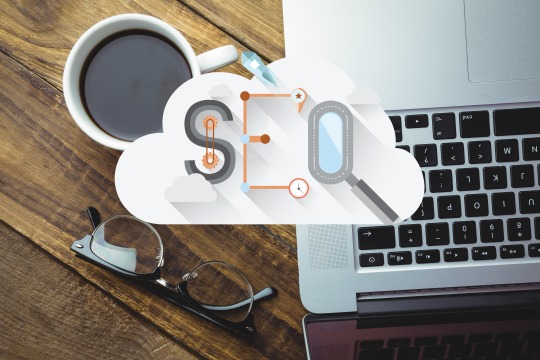
5. Leverage Social Media: Social media platforms offer unparalleled opportunities to connect with your audience and promote your brand. Choose the platforms that align with your target audience's preferences, and craft engaging content that encourages interaction. Paid advertising on social media can also be highly effective in reaching a wider audience.

6. Embrace Data Analytics: Digital marketing provides access to a wealth of data and analytics tools. Monitor key performance indicators (KPIs) such as website traffic, conversion rates, click-through rates, and social media engagement. Use these insights to refine your strategy, identify areas for improvement, and make data-driven decisions.

7. Mobile Optimization: With the increasing use of smartphones and tablets, it's essential to ensure that your website and content are mobile-friendly. A responsive design, fast loading times, and an intuitive user experience on mobile devices can significantly impact your digital marketing success.

In conclusion, digital marketing has become an integral part of today's business landscape. To thrive in this competitive environment, you must define your audience, create a comprehensive strategy, produce high-quality content, optimize for search engines, leverage social media, embrace data analytics, and prioritize mobile optimization. By following these seven essential steps, you can establish a strong online presence, build meaningful connections with your audience, and ultimately achieve your business objectives in today's digital world.
#digital marketing#digital learning#seo#learn digital marketing#proffesional marketer#social media marketing#content marketing#online marketing#internet marketing#mobile marketing#data analytics#target audience#strategy development#marketing stratergies
7 notes
·
View notes
Text
The Promise and Peril of E-learning’s Future
E-learning has transformed the educational landscape, offering unprecedented access to knowledge and skills. However, as with any technological advancement, it carries both promises and perils. Understanding these can help us navigate the future of e-learning effectively.
The Promise of E-learning
1. Accessibility and Convenience
E-learning breaks down geographical barriers, allowing learners from around the world to access educational content. This democratization of education means that anyone with an internet connection can learn from prestigious institutions and expert instructors. The convenience of e-learning also allows learners to study at their own pace and on their own schedule, making it easier to balance education with work and other responsibilities.
2. Personalized Learning Experiences
One of the most significant advantages of e-learning is the ability to tailor educational experiences to individual needs. Adaptive learning technologies use data to adjust the difficulty of tasks and recommend resources based on a learner's progress. This personalized approach can enhance understanding and retention, making learning more efficient and effective.
3. Cost-Effectiveness
E-learning can be more affordable than traditional education. There are no commuting costs, and digital resources can be cheaper than physical textbooks. Additionally, many e-learning platforms offer free courses, making education accessible to a broader audience. This cost-effectiveness extends to institutions as well, which can save on physical infrastructure and administrative expenses.
4. Diverse and Engaging Content
E-learning platforms offer a wide variety of courses and subjects, often in interactive formats that include videos, quizzes, and simulations. This variety can cater to different learning styles and keep learners engaged. Furthermore, the ability to update digital content quickly ensures that learners always have access to the most current information.
5. Lifelong Learning and Professional Development
E-learning supports lifelong learning, allowing individuals to continue their education and professional development throughout their lives. Professionals can update their skills and knowledge without having to take time off work, staying competitive in their fields. This continuous learning culture is essential in a rapidly changing job market.
The Peril of E-learning
1. Digital Divide
While e-learning has the potential to democratize education, it also risks exacerbating existing inequalities. Access to reliable internet and modern devices is not universal, and those without these resources can be left behind. Efforts to bridge the digital divide are crucial to ensure that e-learning benefits everyone.
2. Quality and Accreditation
The quality of e-learning courses can vary significantly. Not all online courses are created equal, and some may lack the rigor and credibility of traditional education. Ensuring that e-learning providers maintain high standards and offer accredited programs is essential to protect learners from subpar educational experiences.
3. Engagement and Motivation
Keeping learners engaged and motivated in an online environment can be challenging. The lack of face-to-face interaction and the potential for distractions at home can hinder progress. E-learning platforms need to incorporate interactive elements, gamification, and community-building features to maintain learner engagement.
4. Assessment and Integrity
Assessing learners in an online environment presents unique challenges. Ensuring that assessments are fair and that academic integrity is maintained can be difficult. Proctoring solutions and sophisticated plagiarism detection tools are necessary to uphold the credibility of e-learning qualifications.
5. Data Privacy and Security
With the increased reliance on digital platforms, data privacy and security concerns have become more prominent. E-learning platforms collect a significant amount of personal data, and protecting this information from breaches and misuse is critical. Implementing robust data protection measures is essential to maintain user trust.
Navigating the Future of E-learning
1. Bridging the Digital Divide
Efforts to provide affordable internet access and devices to underserved communities are essential. Public-private partnerships, government initiatives, and non-profit organizations can play a significant role in addressing this issue. Additionally, e-learning platforms should optimize their content for low-bandwidth environments to ensure inclusivity.
2. Ensuring Quality and Accreditation
Establishing clear standards and accreditation processes for e-learning providers can help maintain quality. Institutions and platforms should collaborate with accrediting bodies to ensure that their courses meet rigorous academic and professional standards. Transparency about course credentials and outcomes can also help learners make informed decisions.
3. Enhancing Engagement and Motivation
To keep learners engaged, e-learning platforms should incorporate interactive and multimedia elements. Gamification, social learning, and collaborative projects can make learning more enjoyable and motivating. Providing regular feedback and recognizing achievements can also boost motivation and persistence.
4. Improving Assessment Methods
Innovative assessment methods, such as project-based evaluations, peer assessments, and open-book exams, can address some of the challenges of online assessments. Proctoring solutions that use AI and biometric verification can enhance the integrity of high-stakes exams. Continuous assessment and formative feedback can support learning and reduce the pressure of final exams.
5. Strengthening Data Privacy and Security
E-learning platforms must prioritize data privacy and security. Implementing strong encryption, secure authentication methods, and regular security audits can protect user data. Clear privacy policies and transparent data practices can build trust with learners. Compliance with data protection regulations, such as GDPR and CCPA, is also essential.
The Role of Technology in E-learning’s Future
1. Artificial Intelligence (AI)
AI has the potential to revolutionize e-learning by providing personalized learning experiences, automating administrative tasks, and supporting predictive analytics. AI-powered chatbots can offer instant support to learners, and adaptive learning systems can tailor content to individual needs.
2. Virtual Reality (VR) and Augmented Reality (AR)
VR and AR can create immersive learning experiences that simulate real-world environments. These technologies are particularly useful for training in fields such as healthcare, engineering, and the arts. By providing hands-on practice in a virtual setting, VR and AR can enhance understanding and skill development.
3. Blockchain
Blockchain technology can enhance the security and transparency of academic credentials. By using blockchain to store and verify certificates and diplomas, e-learning platforms can prevent fraud and ensure the authenticity of qualifications. Learners can have a secure and portable digital record of their achievements.
4. Big Data and Learning Analytics
Big data and learning analytics can provide insights into learner behavior, preferences, and outcomes. By analyzing this data, educators can identify at-risk students, tailor interventions, and continuously improve course design. Data-driven decision-making can enhance the effectiveness and efficiency of e-learning.
5. Mobile Learning
The proliferation of smartphones and tablets has made mobile learning a critical component of e-learning. Optimizing content for mobile devices and developing dedicated apps can ensure that learners have access to education anytime, anywhere. Mobile learning also supports microlearning, which delivers content in small, manageable chunks.
Conclusion
The future of e-learning holds immense promise, but it also presents significant challenges. By addressing the digital divide, ensuring quality and accreditation, enhancing engagement, improving assessment methods, and strengthening data privacy, we can harness the full potential of e-learning.
Technological advancements such as AI, VR, blockchain, big data, and mobile learning will continue to shape the e-learning landscape. Embracing these innovations while maintaining a focus on inclusivity and quality will be key to realizing the promise of e-learning and mitigating its perils.
The journey towards the future of e-learning is ongoing, and stakeholders at all levels—educators, institutions, policymakers, and learners—must collaborate to create an educational ecosystem that is accessible, engaging, and effective for everyone.
#E-learning#Digital education#Online learning#Accessibility#Personalized learning#Adaptive learning#Cost-effective education#Interactive content#Lifelong learning#Professional development#Digital divide#Quality assurance#Accreditation#Learner engagement#Motivation#Assessment integrity#Data privacy#Cybersecurity#Artificial Intelligence (AI)#Virtual Reality (VR)#Augmented Reality (AR)#Blockchain#Big data#Learning analytics#Mobile learning
0 notes
Text
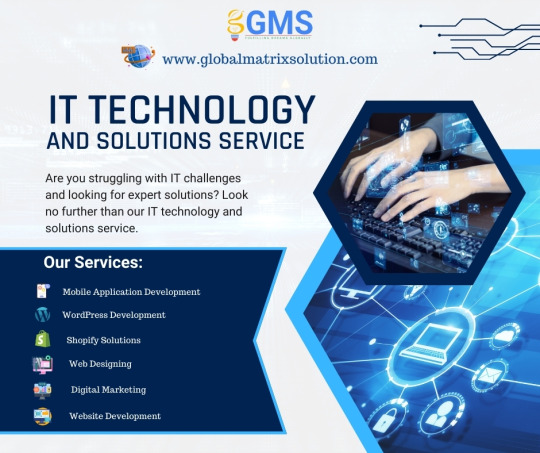
Maximizing Ecommerce Success: Strategies from Global Matrix Solution In the ever-evolving landscape of ecommerce, staying ahead is key to success. At Global Matrix Solution, we understand the challenges businesses face in this dynamic market. That's why we've compiled a list of strategies to help you maximize your ecommerce success.
Optimize Your Website: Your website is your storefront in the digital world. Ensure it's user-friendly, visually appealing, and optimized for mobile devices to provide a seamless shopping experience.
Embrace Technology: Leverage cutting-edge technology solutions to streamline operations, enhance security, and improve customer engagement. From AI-powered chatbots to personalized recommendation engines, technology can take your ecommerce business to new heights.
Focus on Customer Experience: In the competitive world of ecommerce, customer experience is paramount. Prioritize fast shipping, responsive customer service, and easy returns to build trust and loyalty with your customers.
Data-Driven Decision Making: Utilize data analytics to gain insights into customer behavior, market trends, and product performance. This information can inform your marketing strategies, product offerings, and overall business decisions.
Stay Agile: The ecommerce landscape is constantly evolving. Stay agile and adaptable to changes in consumer preferences, technology advancements, and market trends to maintain a competitive edge.
By implementing these strategies, you can position your ecommerce business for long-term success in an increasingly competitive market. Let Global Matrix Solution be your partner in achieving ecommerce excellence.
#Ecommerce Solutions#Online Retail#Digital Commerce#Technology Solutions#Business Strategy#Customer Experience#Data Analytics#Mobile Optimization#Website Design#Marketing Strategies
0 notes
Text
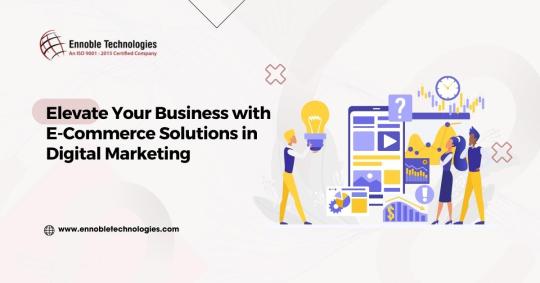
In the fast-paced world of digital marketing, businesses are constantly seeking innovative ways to reach their target audience and drive growth. E-commerce has emerged as a powerful tool that not only expands the reach of businesses but also enhances customer experience. In this comprehensive guide, we will explore the dynamic realm of e-commerce and how it can elevate your business in the digital marketing landscape.
Do Read: https://ennobletechnologies.com/e-commerce/e-commerce-solutions/
#Conversion Rate Optimization#Cross-Platform Shopping#Customer Retention Strategies#Digital Payment Solutions#Digital Storefronts#E-Commerce Analytics#E-Commerce Branding#E-commerce content marketing#E-Commerce Data Analysis#E-Commerce Marketing#E-Commerce Optimization#E-Commerce Platforms#E-Commerce Sales Funnels#e-commerce SEO services#E-Commerce Solutions in Digital Marketing#E-Commerce Website Development#Mobile Shopping Apps#Online Retail Strategies#Payment Gateway Integration#SEO for E-Commerce#Shopping Cart Integration#Social Commerce
1 note
·
View note
Text
Affiliate Marketing in 2024: Riding the Wave of Automation and Personalization
Introduction: Ah, Affiliate Marketing, the grand old dame of the online money-making world! She’s been around since the dawn of the internet, charming marketers and consumers alike. But hold onto your digital hats, folks, because in 2024, this dame is getting a high-tech makeover! 1. The Evolution of Affiliate Marketing: A Quick History Lesson Before we teleport into 2024, let’s hop into our…

View On WordPress
#2024 Trends#Affiliate Marketing#AI in Marketing#Automation#Data Analytics#digital marketing#E-commerce#Ethical Marketing#Influencer Marketing#Marketing Strategy#Mobile Optimization#Online Income#Personalization#seo#social media marketing
1 note
·
View note
Text

IT Solutions for Your Business | Anasol Consultancy Services
Anasol Consultancy services is one of the best IT Services and Marketing Company in Hyderabad. We provide IT Services, Website Development, App Development, E-Commerce Web & Apps, HRMS Development, Training, Salesforce CRM, and Digital Marketing Services including SEO Search Engine Optimization, SEM Search Engine Marketing, SMM Social Media Marketing, Graphic Design, and Content Development. Choose ACS for unparalleled technological solutions that define the future of your business.
visit:https://www.anasolconsultancyservices.com/
Email:[email protected]
Contact :9032091726
Address:1016, 10th floor , DSL abacus IT park , Uppal , Hyderabad , 500039 , India
#online marketing companies in Nagole Hyderabad#Digital marketing agency in Hyderabad#Leadership Training in Hyderabad#App Developers in Nagole Hyderabad#SEO Services in Hyderabad#Data Analytics Services In Hyderabad#Salesforce CRM Developer in Hyderabad#web developers in Hyderabad#app developers in Hyderabad#Web design Services in Hyderabad#Mobile app developers in Hyderabad#Software Solutions in Hyderabad#Mobile App Development Services in Nagole#IT Solutions in Hyderabad
1 note
·
View note
Text
The Value of Aged Domains
The Value of Aged Domains
Is the age of a domain a game-changer in the world of SEO? Let's explore the intriguing realm of aged domains and their impact on search engine rankings. Are they a shortcut to success or just another piece of the puzzle?
Renowned SEO experts have shared contrasting opinions on the importance of aged domains. Rand Fishkin, co-founder of Moz, emphasizes the natural SEO advantage of older domains, highlighting their age and the abundance of backlinks they likely possess. However, Neil Patel, co-founder of Crazy Egg, Hello Bar, and KISSmetrics, cautions that while aged domains can offer a shortcut to SEO success, thorough research and diligence are crucial.
#Social Media Marketing#Search Engine Optimization (SEO)#Content Marketing#Email Marketing#Pay-Per-Click (PPC) Advertising#Influencer Marketing#Affiliate Marketing#Online Public Relations (PR)#Analytics and Data Analysis#Mobile Marketing#Video Marketing#Social Media Advertising#Search Engine Marketing (SEM)#Customer Relationship Management (CRM)#E-commerce Marketing
1 note
·
View note
Text
Unveiling Profit Paradox: Freemium Model of Global Business Success
In the dynamic landscape of the business world, the conventional wisdom dictates that profit is generated through the exchange of goods or services for monetary compensation. However, a fascinating paradox has emerged in recent years – businesses providing free services to users while still reaping substantial annual profits. This freemium model challenges traditional business model and raises…

View On WordPress
#cloud computing profitability#customer data value#digital media monetization#e-commerce platforms#e-learning platforms#free cloud services business#freemium business models#freemium model#gaming industry strategies#grow business#mobile app monetization#online advertising strategies#online marketplace models#open source collaboration#open source software revenue#search engine monetization#social media profitability#streaming service economics#technology business innovations#user data analytics
1 note
·
View note
Text
Changing Landscape of European Retail
Written By: Jagriti Shahi
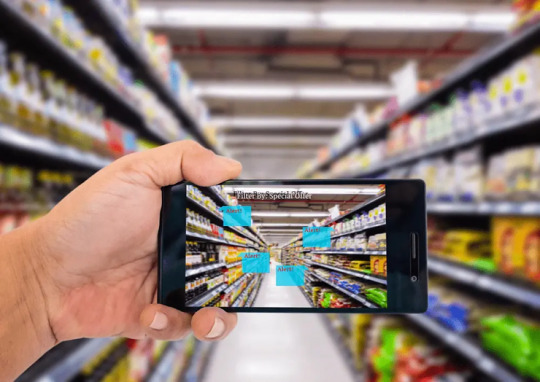
Figure: Growth of retail in Europe
The retail industry in Europe has undergone significant transformations in recent years, driven by changing consumer preferences, technological advancements, and global economic shifts. From traditional brick-and-mortar stores to e-commerce giants, European retail has seen a remarkable evolution. In this article, we will explore the key trends shaping the changing landscape of European retail and how businesses are adapting to stay competitive in this dynamic environment. The retail sector in Europe is the largest in the world, with a turnover of over €2 trillion in 2021. The sector employs over 20 million people and accounts for about 10% of the EU's GDP. The retail sector in Europe is highly fragmented, with a large number of small and medium-sized enterprises (SMEs). However, there are also a number of large multinational retailers operating in the market, such as Carrefour, Tesco, and IKEA.
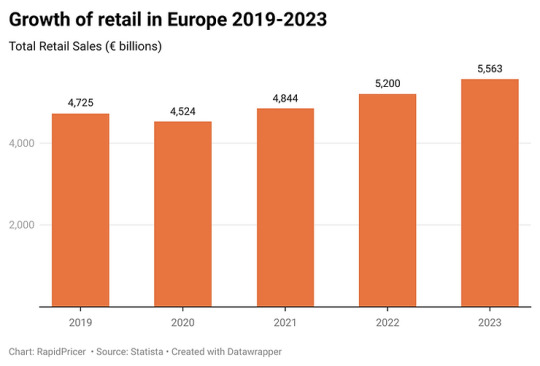
Figure: Growth of retail in Europe
The retail sector in Europe is facing a number of challenges, including the rise of e-commerce, the changing demographics of consumers, and the increasing adoption of new technologies. The rise of e-commerce is one of the most significant challenges facing the retail sector in Europe. In 2021, online retail sales in Europe reached €768 billion, accounting for 16.1% of total retail sales. This growth is being driven by a number of factors, including the increasing availability of high-speed internet, the growing popularity of mobile shopping, and the convenience of online shopping.
Traditional brick-and-mortar retailers are struggling to compete with the convenience and lower prices of online retailers. In order to survive, traditional retailers are investing in their online presence and offering omnichannel experiences that allow customers to shop online and in-store. The demographics of European consumers are also changing, which is having an impact on the retail landscape. The population is aging, with more people over the age of 65. This group is increasingly active and affluent, and they are looking for different products and services than younger consumers. They are also more likely to shop online.
Another demographic trend is the increasing diversity of the European population. This is leading to a demand for more ethnic food and clothing stores. Retailers are also adapting their marketing and advertising to reach these new customer groups.
New technologies are also having a major impact on the retail landscape. The use of artificial intelligence (AI), augmented reality (AR), and virtual reality (VR) is growing, and these technologies are being used to improve the customer experience in a number of ways. For example, AI can be used to personalize recommendations, AR can be used to try on clothes virtually, and VR can be used to create immersive shopping experiences. The adoption of new technologies is also creating new opportunities for retailers. For example, retailers can use data analytics to track customer behavior and improve their marketing and product offerings. They can also use social media to connect with customers and build relationships.
The future of European retail is uncertain, but it is clear that the industry is undergoing a major transformation. The rise of e-commerce, the changing demographics of consumers, and the increasing adoption of new technologies are all having a major impact on the way people shop. Retailers that are able to adapt to these changes will be the ones that are successful in the future.

Figure: Brick-and-Mortar stores
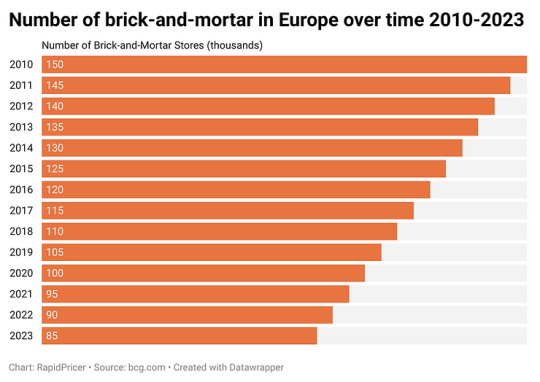
Figure: Number of brick-and-mortar in Europe over time

Figure: Department stores
Department stores: Department stores are large stores that sell a variety of products, such as clothing, home goods, and electronics. Some of the most famous department stores in Europe include Galeries Lafayette in Paris, Selfridges in London, and El Corte Inglés in Madrid.

Figure: Independent retailers
Independent retailers: Independent retailers are small, privately owned businesses that sell a variety of products. These retailers often have a strong local presence and offer a unique shopping experience.

Figure: Markets
Markets: Markets are a great place to find fresh produce, meats, cheeses, and other local products. Many European cities have traditional markets that have been operating for centuries.

Figure: Outlet
Outlet malls: Outlet malls are a great place to find discounted name-brand clothing, shoes, and accessories. These malls are often located in tourist destinations.

Figure: Warehouse clubs
Warehouse clubs: Warehouse clubs are membership-only stores that sell a variety of products in bulk. These clubs are a great place to find discounts on groceries, household goods, and other items.
Traditional retail is still a major part of the retail landscape in Europe, and it is likely to remain so for the foreseeable future. These stores offer a unique shopping experience that cannot be replicated online. In addition, many traditional retailers are adapting to the changing retail landscape by investing in their online presence and offering omnichannel shopping experiences.
The European Retail Landscape
Europe boasts a diverse and rich retail heritage, with traditional shops, boutiques, and markets dating back centuries. These establishments have played a significant role in local economies, offering consumers a wide range of goods and personalized shopping experiences.
Challenges in the Digital Age: Traditional retail in Europe has felt the impact of the digital age. The rapid growth of e-commerce giants like Amazon, along with the convenience of online shopping, has led to a decline in foot traffic at brick-and-mortar stores. Consumers now have access to a vast array of products with the click of a button, making it essential for traditional retailers to adapt.
The Omnichannel Approach: Many traditional European retailers are responding to the digital challenge by adopting an omnichannel approach. This strategy combines physical stores with an online presence, offering consumers a seamless shopping experience. Retailers are investing in e-commerce websites, mobile apps, and in-store technology to bridge the gap between offline and online shopping.
Customer Experience and Personalization: One advantage traditional retailers have over e-commerce is the ability to provide a unique and personalized customer experience. Many European consumers still value the tactile, sensory experience of shopping in a physical store. Traditional retailers are focusing on creating welcoming and interactive environments, offering personalized service, and curating their product selections to cater to local tastes.
Sustainability and Localism: In response to consumer demand for sustainability and ethical shopping, traditional European retailers are emphasizing their commitment to local sourcing and environmentally friendly practices. Some are rediscovering the benefits of locally-produced goods, promoting them as eco-friendly alternatives to mass-produced items. This aligns with the rising trend of supporting local businesses and reducing the carbon footprint associated with global supply chains.
Cultural and Historical Significance: Traditional retail establishments often hold cultural and historical significance in European communities. Many have been in operation for generations, serving as cornerstones of local culture. These stores are cherished by residents and tourists alike, and efforts are made to preserve their historical authenticity while integrating modern retail practices.
Government Support: Some European governments recognize the importance of preserving traditional retail and are offering support through grants, subsidies, and regulatory measures. These initiatives aim to bolster traditional retail against the encroachment of e-commerce and maintain the vibrancy of city centers.
Conclusion
Traditional retail in Europe is at a crossroads. While it faces challenges from the digital age and changing consumer preferences, it also has unique advantages rooted in history, culture, and personalized shopping experiences. To thrive in today's retail landscape, traditional retailers must embrace technology, adopt an omnichannel approach, focus on customer experience, and align with sustainability and localism trends. In doing so, traditional European retail can not only survive but also continue to offer consumers a distinctive and cherished shopping experience that reflects the rich tapestry of Europe's retail heritage. By adapting to the evolving market while preserving their unique qualities, traditional retailers can continue to play a vital role in the continent's commercial landscape.
The changing demographics of consumers
The demographics of European consumers are also changing, which is having an impact on the retail landscape. The population is aging, with more people over the age of 65. This group is increasingly active and affluent, and they are looking for different products and services than younger consumers. They are also more likely to shop online.
Another demographic trend is the increasing diversity of the European population. This is leading to a demand for more ethnic food and clothing stores. Retailers are also adapting their marketing and advertising to reach these new customer groups.
Here are some specific examples of how the changing demographics of consumers are impacting the retail industry in Europe:
The aging population is leading to a demand for more accessible and convenient shopping options. This is driving the growth of online grocery delivery and click-and-collect services.
The increasing diversity of the population is leading to a demand for more ethnic food and clothing stores. This is also leading to a demand for products and services that cater to the needs of diverse cultures, such as halal food and bilingual customer service.
The rise of the digital native is leading to a demand for more personalized and engaging shopping experiences. This is driving the growth of mobile commerce and augmented reality (AR) shopping.
The changing role of women is leading to a demand for more flexible shopping hours and options for online shopping. This is also leading to a demand for more products and services that are designed for women, such as maternity clothing and baby products.
The growing importance of sustainability is leading to a demand for more sustainable products and services. This is driving the growth of organic food, fair trade clothing, and recycled packaging.
The increasing adoption of new technologies
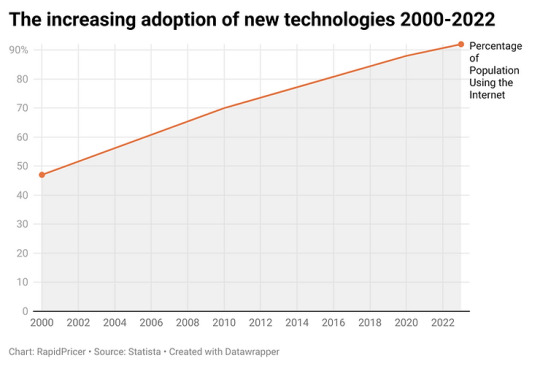
Figure: The increasing adoption of new technologies
As you can see, the percentage of people in Europe using the internet has been increasing steadily over the past two decades. This is due to a number of factors, including the increasing availability of high-speed internet, the falling cost of computers and smartphones, and the growing popularity of online services.
The increasing adoption of new technologies is having a major impact on the retail industry in Europe. Here are some of the key technologies that are being adopted by retailers in Europe:
Artificial intelligence (AI): AI is being used to improve a variety of tasks in the retail industry, such as customer service, inventory management, and fraud detection. For example, AI can be used to analyze customer data to personalize recommendations, or to predict which products are likely to be in high demand.
Augmented reality (AR): AR is being used to create immersive shopping experiences that allow customers to try on clothes virtually or see how furniture would look in their home. For example, IKEA has an AR app that allows customers to see how its furniture would look in their living room.
Virtual reality (VR): VR is being used to create even more immersive shopping experiences that allow customers to virtually visit stores and try on products. For example, Amazon has a VR store that allows customers to browse its products and make purchases.
Internet of Things (IoT): IoT is being used to connect devices and collect data about customer behavior. This data can be used to improve a variety of tasks, such as inventory management and customer service. For example, retailers can use IoT sensors to track the movement of products in stores and to identify when products are running low.
Blockchain: Blockchain is being used to create secure and transparent supply chains. This can help retailers to ensure the authenticity of their products and to track their products from the source to the customer. For example, Walmart is using blockchain to track the supply chain of its food products.
These are just some of the key technologies that are being adopted by retailers in Europe. The adoption of these technologies is helping retailers to improve their efficiency, personalize the customer experience, and create a more sustainable supply chain.
E-Commerce Dominance
One of the most profound shifts in European retail has been the rise of e-commerce. Consumers now have the convenience of shopping online from the comfort of their homes, and this trend has been accelerated by the COVID-19 pandemic. Major players like Amazon, Alibaba, and local champions such as Zalando and ASOS have expanded their reach across Europe, reshaping consumer behavior and expectations. Retailers have had to invest heavily in their online presence, enhancing websites, mobile apps, and supply chain logistics to meet the demand for digital shopping. Additionally, omnichannel strategies have become essential, allowing consumers to seamlessly switch between online and offline shopping experiences.
E-commerce dominance refers to the growing market share of online retailers over traditional brick-and-mortar stores. This trend is being driven by a number of factors, including the increasing availability of high-speed internet, the growing popularity of mobile shopping, and the convenience of online shopping. In Europe, e-commerce sales are expected to reach €768 billion in 2022, accounting for 16.1% of total retail sales. This growth is being driven by the increasing adoption of online shopping by consumers across all demographics.
There are a number of reasons why e-commerce is becoming so dominant. First, the availability of high-speed internet has made it possible for consumers to shop online quickly and easily. Second, the popularity of mobile shopping has made it possible for consumers to shop online from anywhere. Third, the convenience of online shopping is unmatched by traditional brick-and-mortar stores. Consumers can shop online 24/7, compare prices from different retailers, and have products delivered to their door. The rise of e-commerce is having a major impact on the retail industry. Traditional brick-and-mortar stores are facing increasing competition from online retailers, and many are struggling to compete. In order to survive, traditional retailers need to adapt to the changing retail landscape by investing in their online presence and offering omnichannel shopping experiences.

Figure: Share of online retail sales in Europe over time
As you can see, the share of online retail sales in Europe has been increasing steadily in recent years. This is due to the increasing popularity of online shopping, which is more convenient and offers a wider selection of products. The share of online retail sales is expected to continue to increase in the coming years. However, it is important to note that not all countries are affected equally. For example, the share of online retail sales is higher in Northern Europe than in Southern Europe. The future of online retail in Europe is bright. The growth of online shopping is being driven by a number of factors, including the increasing availability of high-speed internet, the growing popularity of smartphones and tablets, and the increasing convenience of online shopping.
Sustainability and Ethical Consumption
The European retail landscape is witnessing a significant shift towards sustainability and ethical consumption. Consumers are becoming increasingly aware of the environmental and social impact of their purchases. Retailers are responding by adopting eco-friendly practices, sourcing sustainable products, and promoting transparency in their supply chains.
Fashion brands, in particular, have made strides in sustainable fashion, with initiatives like "slow fashion" and clothing rental services gaining popularity. European consumers are favoring products that are produced responsibly and have a lower environmental footprint, and retailers are aligning their strategies with these values.
Personalization and Data Analytics
Data analytics and artificial intelligence are playing a crucial role in the transformation of European retail. Retailers are harnessing the power of big data to gain insights into consumer behavior, preferences, and shopping habits. This data-driven approach allows them to personalize marketing efforts, optimize inventory management, and enhance the overall shopping experience.
Personalized recommendations, targeted advertising, and tailored promotions are becoming the norm in the industry. Retailers are using predictive analytics to forecast trends and adjust their product offerings accordingly, ensuring they stay ahead of consumer demands.
Pop-Up Stores and Experiential Retail
While online shopping continues to grow, physical stores are not becoming obsolete. Instead, retailers are reimagining the in-store experience to attract and engage customers. Pop-up stores and experiential retail spaces are gaining popularity, offering unique and immersive experiences that cannot be replicated online.
These temporary stores allow retailers to test new products and connect with customers on a more personal level. They often incorporate interactive elements, such as virtual reality experiences or live demonstrations, to create memorable moments for shoppers.
Cross-Border Expansion
European retailers are increasingly looking beyond their home markets for growth opportunities. Cross-border expansion has become a viable strategy for many companies seeking to tap into new customer bases and diversify revenue streams. The European Union's single market has facilitated this expansion by reducing trade barriers and harmonizing regulations.
Furthermore, technology has made it easier for retailers to reach international customers through e-commerce platforms and digital marketing. As a result, many European brands are expanding their presence into neighboring countries and even outside of Europe, creating a more competitive and globalized retail landscape.
Post COVID European Retail
The retail industry in Europe is undergoing a period of change after COVID. The pandemic has accelerated the shift to online shopping, and brick-and-mortar stores are struggling to compete. Retailers are responding by adopting new technologies, such as AR and VR, and by offering more convenient shopping experiences, such as BOPIS. The industry is also focusing on sustainability, as consumers are increasingly demanding sustainable products and services.
Conclusion
The changing landscape of European retail is characterized by the rapid growth of e-commerce, a focus on sustainability and ethical consumption, data-driven personalization, experiential in-store experiences, and cross-border expansion. Retailers that adapt to these trends and embrace digital transformation are likely to thrive in this dynamic environment.
The future of European retail will continue to be shaped by evolving consumer preferences and technological innovations. To stay relevant, retailers must remain agile, customer-centric, and committed to ethical and sustainable practices. As the industry continues to evolve, it will be exciting to see how retailers innovate and compete in this ever-changing landscape.
About RapidPricer
RapidPricer helps automate pricing, promotions and assortment for retailers. The company has capabilities in retail pricing, artificial intelligence and deep learning to compute merchandising actions for real-time execution in a retail environment.
Contact info:
Website: https://www.rapidpricer.com/
LinkedIn: https://www.linkedin.com/company/rapidpricer/
Email: [email protected]
#European Retail Industry#Retail Trends in Europe#E-commerce Growth#Brick-and-Mortar Stores#Omnichannel Retailing#Digital Transformation#Consumer Behavior#Sustainability in Retail#Retail Technology#Online Marketplaces#Supply Chain Disruptions#Post-Pandemic Retail#Retail Innovation#Mobile Shopping#Data Analytics in Retail#Cross-Border Shopping#Pop-Up Stores#Customer Experience#Retail Competition#Retailer Partnerships#Retail Regulations#Future of Retail in Europe#Retail Challenges#Local vs. Global Retailers#Retail Adaptation Strategies
0 notes
Text
Amplify Your Reach: Embracing the Power of Digital Marketing
Unleash your brand's potential with digital marketing! Reach wider audiences, boost engagement, and skyrocket your success. Embrace the power of digital marketing today!
In today’s fast-paced and highly competitive business world, the role of digital marketing cannot be overstated. Digital marketing empowers businesses to expand reach and establish a formidable online presence. Traditional marketing methods alone are no longer sufficient to meet the demands and expectations of modern consumers. Harness digital marketing’s power to connect with your audience and…

View On WordPress
#Brand Awareness#Conversion Optimisation#Customer Engagement#data analytics#Digital Marketing Strategy#E-com Marketing#Email Marketing#Mobile Marketing#Online Advertising#Pay-Per-Click Ads#ROI in Digital Marketing#SEO#social media marketing#Website Optimisation
1 note
·
View note
Text
So I don't know how people on this app feel about the shit-house that is TikTok but in the US right now the ban they're trying to implement on it is a complete red herring and it needs to be stopped.
They are quite literally trying to implement Patriot Act 2.0 with the RESTRICT Act and using TikTok and China to scare the American public into buying into it wholesale when this shit will change the face of the internet. Here are some excerpts from what the bill would cover on the Infrastructure side:
SEC. 5. Considerations.
(a) Priority information and communications technology areas.—In carrying out sections 3 and 4, the Secretary shall prioritize evaluation of— (1) information and communications technology products or services used by a party to a covered transaction in a sector designated as critical infrastructure in Policy Directive 21 (February 12, 2013; relating to critical infrastructure security and resilience);
(2) software, hardware, or any other product or service integral to telecommunications products and services, including— (A) wireless local area networks;
(B) mobile networks;
(C) satellite payloads;
(D) satellite operations and control;
(E) cable access points;
(F) wireline access points;
(G) core networking systems;
(H) long-, short-, and back-haul networks; or
(I) edge computer platforms;
(3) any software, hardware, or any other product or service integral to data hosting or computing service that uses, processes, or retains, or is expected to use, process, or retain, sensitive personal data with respect to greater than 1,000,000 persons in the United States at any point during the year period preceding the date on which the covered transaction is referred to the Secretary for review or the Secretary initiates review of the covered transaction, including— (A) internet hosting services;
(B) cloud-based or distributed computing and data storage;
(C) machine learning, predictive analytics, and data science products and services, including those involving the provision of services to assist a party utilize, manage, or maintain open-source software;
(D) managed services; and
(E) content delivery services;
(4) internet- or network-enabled sensors, webcams, end-point surveillance or monitoring devices, modems and home networking devices if greater than 1,000,000 units have been sold to persons in the United States at any point during the year period preceding the date on which the covered transaction is referred to the Secretary for review or the Secretary initiates review of the covered transaction;
(5) unmanned vehicles, including drones and other aerials systems, autonomous or semi-autonomous vehicles, or any other product or service integral to the provision, maintenance, or management of such products or services;
(6) software designed or used primarily for connecting with and communicating via the internet that is in use by greater than 1,000,000 persons in the United States at any point during the year period preceding the date on which the covered transaction is referred to the Secretary for review or the Secretary initiates review of the covered transaction, including— (A) desktop applications;
(B) mobile applications;
(C) gaming applications;
(D) payment applications; or
(E) web-based applications; or
(7) information and communications technology products and services integral to— (A) artificial intelligence and machine learning;
(B) quantum key distribution;
(C) quantum communications;
(D) quantum computing;
(E) post-quantum cryptography;
(F) autonomous systems;
(G) advanced robotics;
(H) biotechnology;
(I) synthetic biology;
(J) computational biology; and
(K) e-commerce technology and services, including any electronic techniques for accomplishing business transactions, online retail, internet-enabled logistics, internet-enabled payment technology, and online marketplaces.
(b) Considerations relating to undue and unacceptable risks.—In determining whether a covered transaction poses an undue or unacceptable risk under section 3(a) or 4(a), the Secretary— (1) shall, as the Secretary determines appropriate and in consultation with appropriate agency heads, consider, where available— (A) any removal or exclusion order issued by the Secretary of Homeland Security, the Secretary of Defense, or the Director of National Intelligence pursuant to recommendations of the Federal Acquisition Security Council pursuant to section 1323 of title 41, United States Code;
(B) any order or license revocation issued by the Federal Communications Commission with respect to a transacting party, or any consent decree imposed by the Federal Trade Commission with respect to a transacting party;
(C) any relevant provision of the Defense Federal Acquisition Regulation and the Federal Acquisition Regulation, and the respective supplements to those regulations;
(D) any actual or potential threats to the execution of a national critical function identified by the Director of the Cybersecurity and Infrastructure Security Agency;
(E) the nature, degree, and likelihood of consequence to the public and private sectors of the United States that would occur if vulnerabilities of the information and communications technologies services supply chain were to be exploited; and
(F) any other source of information that the Secretary determines appropriate; and
(2) may consider, where available, any relevant threat assessment or report prepared by the Director of National Intelligence completed or conducted at the request of the Secretary.

Look at that, does that look like it just covers the one app? NO! This would cover EVERYTHING that so much as LOOKS at the internet from the point this bill goes live.
It gets worse though, you wanna see what the penalties are?

(b) Civil penalties.—The Secretary may impose the following civil penalties on a person for each violation by that person of this Act or any regulation, order, direction, mitigation measure, prohibition, or other authorization issued under this Act: (1) A fine of not more than $250,000 or an amount that is twice the value of the transaction that is the basis of the violation with respect to which the penalty is imposed, whichever is greater. (2) Revocation of any mitigation measure or authorization issued under this Act to the person. (c) Criminal penalties.— (1) IN GENERAL.—A person who willfully commits, willfully attempts to commit, or willfully conspires to commit, or aids or abets in the commission of an unlawful act described in subsection (a) shall, upon conviction, be fined not more than $1,000,000, or if a natural person, may be imprisoned for not more than 20 years, or both. (2) CIVIL FORFEITURE.— (A) FORFEITURE.— (i) IN GENERAL.—Any property, real or personal, tangible or intangible, used or intended to be used, in any manner, to commit or facilitate a violation or attempted violation described in paragraph (1) shall be subject to forfeiture to the United States. (ii) PROCEEDS.—Any property, real or personal, tangible or intangible, constituting or traceable to the gross proceeds taken, obtained, or retained, in connection with or as a result of a violation or attempted violation described in paragraph (1) shall be subject to forfeiture to the United States. (B) PROCEDURE.—Seizures and forfeitures under this subsection shall be governed by the provisions of chapter 46 of title 18, United States Code, relating to civil forfeitures, except that such duties as are imposed on the Secretary of Treasury under the customs laws described in section 981(d) of title 18, United States Code, shall be performed by such officers, agents, and other persons as may be designated for that purpose by the Secretary of Homeland Security or the Attorney General. (3) CRIMINAL FORFEITURE.— (A) FORFEITURE.—Any person who is convicted under paragraph (1) shall, in addition to any other penalty, forfeit to the United States— (i) any property, real or personal, tangible or intangible, used or intended to be used, in any manner, to commit or facilitate the violation or attempted violation of paragraph (1); and (ii) any property, real or personal, tangible or intangible, constituting or traceable to the gross proceeds taken, obtained, or retained, in connection with or as a result of the violation. (B) PROCEDURE.—The criminal forfeiture of property under this paragraph, including any seizure and disposition of the property, and any related judicial proceeding, shall be governed by the provisions of section 413 of the Controlled Substances Act (21 U.S.C. 853), except subsections (a) and (d) of that section.
You read that right, you could be fined up to A MILLION FUCKING DOLLARS for knowingly violating the restrict act, so all those people telling you to "just use a VPN" to keep using TikTok? Guess what? That falls under the criminal guidelines of this bill and they're giving you some horrible fucking advice.
Also, VPN's as a whole, if this bill passes, will take a goddamn nose dive in this country because they are another thing that will be covered in this bill.
They chose the perfect name for it, RESTRICT, because that's what it's going to do to our freedoms in this so called "land of the free".
Please, if you are a United States citizen of voting age reach out to your legislature and tell them you do not want this to pass and you will vote against them in the next primary if it does. This is a make or break moment for you if you're younger. Do not allow your generation to suffer a second Patriot Act like those of us that unfortunately allowed for the first one to happen.
And if you support this, I can only assume you're delusional or a paid shill, either way I hope you rot in whatever hell you believe in.
#politics#restrict bill#tiktok#tiktok ban#s.686#us politics#tiktok senate hearing#land of the free i guess#patriot act#patriot act 2.0
895 notes
·
View notes
Text

A BL Platform For Everyone
NB: Please reblog this for visibility!
A little over two years ago, me and my BL crew were in our little chat sharing recommendations.
Cat had an impressive spread sheet, Marcie and I had iCloud Notes, and it was pretty much chaos.
I looked at it and said out loud, "There has to be a better way for us to keep track of our reads and share recommendations. There has to be right?"
Cat said she wished someone would build a BL app with everything already there. Me, a developer of almost thirty years, paused while a floodlight (not a light bulb) went off in my head.
“Well I could maybe build one… cause like, I build stuff. How would that be?”
By the end of the conversation Cat had invited me to build an app for BL.
Four weeks later, in late February of 2022, digitaljuicy.com was online.
In the last couple of years, I’ve been listening to the fandom, paying attention to feedback, poured over analytics, read your responses to the Reader’s Survey and continued to craft a platform with all this in mind.
What I have been building is 100% for us... there is nothing but BL and it is an attempt to encompass ALL of BL. Not just the bits and pieces.
But for two years I've been struggling. Struggling in many ways, but specifically to get what I wanted out of the platform. I tried and failed so many times.
In September of 2022 I tried to raise venture capital to build the platform I wanted for us. I pitched it to accelerators and true blue venture capital.
Juicy is what is called 'pre-seed'. Which means were still so new and evolving, under-resourced and while there was interest, there was no joy. No funding was raised.
In December 2023, I realised it was time to rethink Juicy. i have been on the deepest dive for months rebuilding Juicy from the ground up and preparing the framework for the mobile app.
I’ve built something I want to use… and wild, I’m building it and using it as a fan at the same time. I'm at the point where it's impossible not to want to share.
And what kind of platform do I mean? At its most basic level:
You can track your reads, watches and plays
You can review and recommend the titles to the community, your friends, strangers on Twitter, your friend you're trying to corrupt outside the fandom. Your poison.
Timelines for you, for titles, for episodes, chapters… just about everything. I mean everything: The creators, the publishers, the studios, the actors... you can leave reviews and status posts on EVERYTHING. No algorithms, no force feeding... just discovery, recommendations and honest reviews by this community about our community and the industry we feed.
Collections! Lists of stuff you're reading, dropped, want to read, want to buy, love or hate, all pretty and organised and shareable..
A growing database resource of titles, tagged up to its eyeballs with a minutiae of data.. with reading an streaming links and anything else we find that we think is relevant.
But it is also a lot more than this.
I wanted it to be more than what it was. I want to turn Juicy into a mobile app, add some more functionality and more specifically, platform all of BL for its non-Asian fandom.
We get left out of so much, I feel like we need our own thing.
I don’t know about ya’ll, but I was tired of being banned on social media for sharing content. How you gonna ban me for saying a 2D fictional character needs to be shot with shite and strung with cobweb? But they did… and I know it’s not just me.
What about the creators? How do they interface with the non-Japanese or non-Korean fandoms? On which misogynistic hell site?
What about the publishers and merchandisers? What about the little Etsy sellers? Why does BL have to hidden away in the databases of mangaupdates, anisearch and anilist? Why does every single manga tracker out there seem to have pitiful listings for BL?
Is it because we’re a female or queer audience?
Look at this lil video I made:
youtube
Either way, I’ve long felt it’s time for us to do our own thing. So I’ve been building it. Pixel by pixel. Feature by feature on my own.
Juicy has been a small chat group, but I’m the only developer. We’ve always been clear about what we wanted to build: A platform for the fandom, the creators, the publishers, the merchandisers… my goal is a one-stop platform for BL and I am damn close to presenting this new iteration.
This was and remains the core of what I’m building: The largest English platform for BL on the planet. The functionality is one thing, but building a database like that is not a one-person job.
So now I need your help.
First to keep the servers online, so I can continue to build and develop and finally, finally release the mobile app. I can't tell you how much I want that.
I’m close to pushing the new Juicy 3.0 out, and I’m very in love with the work I’ve done since December. It’s a new look, and it works 1000 times better than the previous iterations of Juicy.
I just have hit a wall financially, and need your help and support to get it over the line.
Juicy's ass is fat and I been carrying her mostly alone for two solid years.
I’m going to launch a Kickstarter for this project in a bit so I can hire another developer to help with the trickier bits and fine tune the mobile app, but for now, I felt a Patreon would at least help us keep the servers up and maybe, just maybe allow us to afford a few crucial bits that will elevate your experience as a user.
And because I’m a developer, and I can do some pretty kinky shit with APIs and such, if you support this Patreon campaign, you will get some nice feature perks on the platform automagically. You won’t have to pay again to access these perks in-app later.
As many perks as I can cook up anyway, not the least of which will be access to some of the nicer functions and features I’ve already built into the platform.
When the mobile app launches, you will get it first and for free! Plus we’ve been talking about a lot of other ways we can make the platform fun beyond what I've done already.
I plan to monetise the platform in various ways, but in a profit sharing model. You contribute to the database, you contribute content, you get a share of whatever the platform makes. This is already built into the system. This will be open to anyone willing, but to Patrons first.
Finally, I'm limiting the number of people who can subscribe via Patreon to 1000 people. Once we hit that number, the rolls will be closed to new membership, and everyone directed to the platform to pay for any services or merchandise.
My goal for this group of Patrons is that you become an exclusive and tightly knit inner circle.
My hope is that you will help me actively shape what Juicy will become. Your votes and say will carry weight. Your feature requests considered and if possible implemented first.
You will get access to exclusive merchandise, exclusive giveaways and promos (like free stuff), and exclusive programming from the team.
With your help we will produce an exclusive podcast for Patrons only discussing all things BL and Juicy (honestly our conversations are generally wild and hilarious... it will be a rollick for sure), along with other content for Patrons only. We've even planned watch parties and other fun shit... I swear, we want you all to be our greatest ambassadors so we are planning as many treats as we can.
Your access on the platform will be specific to your Patreon subscription and your treatment will be VIP for the life of your subscription.
Finally, the way my auADHD are set up, I have no interest in the dramas of the BL fandom, so this is never going to be about gatekeeping access to anything. It’s about making more access possible. You can help bring us all together and make us stronger as a group.
So do you think Digital Juicy sounds like something you’d like in on?
Okute Sea
Saezuru Murmurs
#saezuru tori wa habatakanai#painter of the night#saezuru fandom#potn#thai boys love#yaoi#yaoi manga#yaoi anime#korean bl#taiwan bl#19 days#jinx mingwa#boys love#shounen ai#bl manhwa#yawhacheop#seungho x nakyum#bl comic#bl manga#bl drama#bl anime#twittering birds never fly#saezuru#yaoi bl#bl fandom#bl fanart#Youtube
37 notes
·
View notes
Text
The "Essential" mod for Minecraft: Java Edition collects your personal data and shares it with advertisers

"We also work with (or may in the future work with) analytics service providers, advertisers and ad agencies, and other vendors to provide them with information regarding traffic on the Platform, including pages viewed, content interacted with, and actions taken by Users when visiting the Platform; to serve advertisements on other web sites, within mobile apps and elsewhere online; and to provide us with information regarding the use of the Platform and the effectiveness of our advertisements and other marketing campaigns. Our service providers may collect certain information about your visits to, and activity on, the Platform as well as other websites or services, they may set and access their own tracking technologies on your device (including Cookies and Web Beacons), and they may use that information to show you targeted advertisements. Some of these parties may collect Personal Information when you visit the Platform or other online websites and services. We may also share certain non-Personal Information with these parties, in connection with the services they provide to us."
(as outlined in Section 5 of the Privacy Policy)
75 notes
·
View notes
Text
Elevate Your Business with E-Commerce Solutions in Digital Marketing
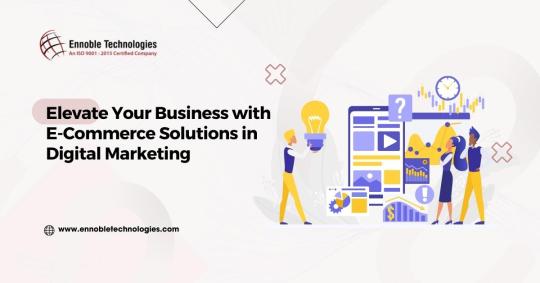
In the fast-paced world of digital marketing, businesses are constantly seeking innovative ways to reach their target audience and drive growth. E-commerce has emerged as a powerful tool that not only expands the reach of businesses but also enhances customer experience. In this comprehensive guide, we will explore the dynamic realm of e-commerce and how it can elevate your business in the digital marketing landscape.
Understanding E-Commerce
Defining E-Commerce
E-commerce, short for electronic commerce, refers to the buying and selling of goods and services over the internet. It has revolutionized the way businesses operate, enabling them to reach a global audience with the click of a button.
Types of E-Commerce Models
B2B E-Commerce: Business-to-business e-commerce involves transactions between businesses. This model is often characterized by bulk orders and long-term partnerships.
B2C E-Commerce: Business-to-consumer e-commerce focuses on selling products and services directly to individual consumers. It’s the most common e-commerce model.
C2C E-Commerce: Customer-to-customer e-commerce platforms enable individuals to buy and sell products among themselves. Online marketplaces facilitate these transactions.

The Evolution of E-Commerce
E-commerce has come a long way from its inception in the 1990s. From basic online catalogs to sophisticated, AI-driven shopping experiences, it continues to evolve, presenting new opportunities and challenges for businesses.
Why E-Commerce is Crucial in Digital Marketing
Expanding Your Reach
E-commerce erases geographical boundaries, allowing your business to reach customers worldwide. With the right digital marketing strategies, your products can find their way to consumers across the globe.
24/7 Availability
Unlike traditional brick-and-mortar stores with fixed operating hours, e-commerce platforms are open 24/7. This accessibility ensures that potential customers can shop at their convenience.
Cost-Effectiveness
Running an e-commerce store is often more cost-effective than maintaining a physical retail space. There are no rent, utilities, or other overheads to worry about.
Personalization and Customer Experience
E-commerce platforms can collect data on customer preferences and behavior. This data can be used to create personalized shopping experiences, making customers feel valued and understood.
Setting Up Your E-Commerce Store
Choosing the Right E-Commerce Platform
Selecting the appropriate e-commerce platform is crucial. Options like Shopify, WooCommerce, and BigCommerce offer varying levels of customization and scalability.
Design and User Experience
A well-designed e-commerce site with a user-friendly interface is more likely to convert visitors into customers. The visual appeal and ease of navigation are vital.
Continue Reading: https://ennobletechnologies.com/e-commerce/e-commerce-solutions/
#Conversion Rate Optimization#Cross-Platform Shopping#Customer Retention Strategies#Digital Payment Solutions#Digital Storefronts#E-Commerce Analytics#E-Commerce Branding#E-commerce content marketing#E-Commerce Data Analysis#E-Commerce Marketing#E-Commerce Optimization#E-Commerce Platforms#E-Commerce Sales Funnels#e-commerce SEO services#E-Commerce Solutions in Digital Marketing#E-Commerce Website Development#Mobile Shopping Apps#Online Retail Strategies#Payment Gateway Integration#SEO for E-Commerce#Shopping Cart Integration#Social Commerce
1 note
·
View note
Text
AI & IT'S IMPACT
Unleashing the Power: The Impact of AI Across Industries and Future Frontiers
Artificial Intelligence (AI), once confined to the realm of science fiction, has rapidly become a transformative force across diverse industries. Its influence is reshaping the landscape of how businesses operate, innovate, and interact with their stakeholders. As we navigate the current impact of AI and peer into the future, it's evident that the capabilities of this technology are poised to reach unprecedented heights.
1. Healthcare:
In the healthcare sector, AI is a game-changer, revolutionizing diagnostics, treatment plans, and patient care. Machine learning algorithms analyze vast datasets to identify patterns, aiding in early disease detection. AI-driven robotic surgery is enhancing precision, reducing recovery times, and minimizing risks. Personalized medicine, powered by AI, tailors treatments based on an individual's genetic makeup, optimizing therapeutic outcomes.
2. Finance:
AI is reshaping the financial industry by enhancing efficiency, risk management, and customer experiences. Algorithms analyze market trends, enabling quicker and more accurate investment decisions. Chatbots and virtual assistants powered by AI streamline customer interactions, providing real-time assistance. Fraud detection algorithms work tirelessly to identify suspicious activities, bolstering security measures in online transactions.
3. Manufacturing:
In manufacturing, AI is optimizing production processes through predictive maintenance and quality control. Smart factories leverage AI to monitor equipment health, reducing downtime by predicting potential failures. Robots and autonomous systems, guided by AI, enhance precision and efficiency in tasks ranging from assembly lines to logistics. This not only increases productivity but also contributes to safer working environments.
4. Education:
AI is reshaping the educational landscape by personalizing learning experiences. Adaptive learning platforms use AI algorithms to tailor educational content to individual student needs, fostering better comprehension and engagement. AI-driven tools also assist educators in grading, administrative tasks, and provide insights into student performance, allowing for more effective teaching strategies.
5. Retail:
In the retail sector, AI is transforming customer experiences through personalized recommendations and efficient supply chain management. Recommendation engines analyze customer preferences, providing targeted product suggestions. AI-powered chatbots handle customer queries, offering real-time assistance. Inventory management is optimized through predictive analytics, reducing waste and ensuring products are readily available.
6. Future Frontiers:
A. Autonomous Vehicles: The future of transportation lies in AI-driven autonomous vehicles. From self-driving cars to automated drones, AI algorithms navigate and respond to dynamic environments, ensuring safer and more efficient transportation. This technology holds the promise of reducing accidents, alleviating traffic congestion, and redefining mobility.
B. Quantum Computing: As AI algorithms become more complex, the need for advanced computing capabilities grows. Quantucm omputing, with its ability to process vast amounts of data at unprecedented speeds, holds the potential to revolutionize AI. This synergy could unlock new possibilities in solving complex problems, ranging from drug discovery to climate modeling.
C. AI in Creativity: AI is not limited to data-driven tasks; it's also making inroads into the realm of creativity. AI-generated art, music, and content are gaining recognition. Future developments may see AI collaborating with human creators, pushing the boundaries of what is possible in fields traditionally associated with human ingenuity.
In conclusion, the impact of AI across industries is profound and multifaceted. From enhancing efficiency and precision to revolutionizing how we approach complex challenges, AI is at the forefront of innovation. The future capabilities of AI hold the promise of even greater advancements, ushering in an era where the boundaries of what is achievable continue to expand. As businesses and industries continue to embrace and adapt to these transformative technologies, the synergy between human intelligence and artificial intelligence will undoubtedly shape a future defined by unprecedented possibilities.
19 notes
·
View notes
Text
New Business Marketing Tips and Tricks for Success
Starting a new business can be an exhilarating adventure, but it also comes with its fair share of challenges, especially in the competitive landscape of today's marketplace. To stand out and thrive, effective marketing is crucial. Here are four essential marketing tips and tricks to help your new business succeed:
Define Your Target Audience and Create Customer Personas:
One of the first steps in crafting a successful marketing strategy for your new business is to identify and understand your target audience. Who are your ideal customers, and what are their needs, preferences, and pain points? Creating customer personas can help you visualize and humanize your audience, making it easier to tailor your marketing efforts effectively.

Start by conducting market research to gather data about your potential customers. Analyze demographics, psychographics, and behavior patterns to create detailed customer personas. These personas should include information like age, gender, income, interests, and pain points.
Once you have a clear understanding of your target audience, customize your marketing messages and strategies to resonate with them. Craft compelling content, advertisements, and promotions that address their specific needs and desires. By speaking directly to your ideal customers, you'll increase the chances of building meaningful connections and driving conversions.
Leverage the Power of Digital Marketing:
In the digital age, online presence and digital marketing are indispensable for any new business. Here are some essential digital marketing strategies to consider:
a. Build a User-Friendly Website: Your website is often the first point of contact for potential customers. Ensure that it is well-designed, easy to navigate, and mobile-responsive. Optimize it for search engines (SEO) to improve your visibility in search results.
b. Content Marketing: Create valuable and relevant content that educates, entertains, or solves problems for your target audience. Blog posts, videos, infographics, and social media updates can all be part of your content marketing strategy.

c. Social Media Marketing: Identify the social media platforms where your audience is most active and engage with them there. Develop a content calendar and use a mix of organic and paid content to reach a wider audience.
d. Email Marketing: Build and nurture an email list to stay in touch with your customers. Send personalized and relevant content, offers, and updates to keep them engaged and informed.
e. Pay-Per-Click Advertising (PPC): Consider running targeted PPC campaigns on platforms like Google Ads and Facebook Ads to reach potential customers actively searching for your products or services.
Emphasize Customer Relationships and Engagement:
In a competitive market, building and maintaining strong customer relationships is vital. Consider these strategies to enhance customer engagement:
a. Provide Exceptional Customer Service: Respond promptly to inquiries and address customer concerns with care. Happy customers are more likely to become loyal advocates for your brand.
b. Personalization: Use customer data and segmentation to personalize your marketing messages and offers. People appreciate tailored experiences that cater to their unique preferences.

c. Encourage User-Generated Content: Encourage customers to share their experiences with your products or services on social media or review platforms. User-generated content can build trust and credibility.
d. Loyalty Programs: Reward repeat customers with loyalty programs, discounts, or exclusive access to new products or services. Loyalty programs can foster long-term relationships and increase customer retention.
Monitor, Analyze, and Adapt:
Marketing is not a one-size-fits-all endeavor. To continually improve your strategies, track key performance indicators (KPIs) and adapt based on the data:
a. Use Analytics Tools: Employ tools like Google Analytics, social media insights, and email marketing metrics to monitor the performance of your marketing efforts.
b. A/B Testing: Experiment with different marketing approaches and compare their results through A/B testing. This allows you to refine your strategies over time.

c. Stay Informed: Keep up with industry trends, competitors, and evolving customer preferences. Stay open to adjusting your marketing plan as needed.
In conclusion, successful marketing for a new business involves understanding your audience, utilizing digital strategies, fostering customer relationships, and staying adaptable. By implementing these tips and tricks, your new business can navigate the competitive landscape and carve out its own path to success.
#seo#online marketing#digitalmarketing#marketing agency#learn digital marketing#digital marketing service#seo marketing#digital marketing course#digital marketing#seo expert#business success#business marketing#marketing tips
22 notes
·
View notes